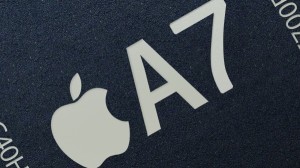Apple fans have been craving some innovation for a while and the company seemed to deliver it Tuesday with the new A7 chip in the iPhone 5S, the first 64-bit processor to appear in a smartphone.

But while the A7 sets the iPhone up for the future, the short-term gains will be minimal and users might not notice a big performance difference for some time, analysts said.
“With current mobile devices and mobile apps, there really is no advantage [to 64 bits] other than marketing — the ability to say you’re the first to have it,” said Jim McGregor, principal analyst at Tirias Research.
Nathan Brookwood, principal analyst at Insight64, said it’s unclear how much noticeable performance improvement users will see, at least until apps that take advantage of the new chip are released.
“Apple’s going to be shipping 64-bit smartphones before anyone in the Android camp. Whether that will matter is up in the air,” he said.
For sure, the new chip should give better performance than its predecessors, it’s just not clear how much of that improvement will come from the fact that it’s 64 bits.
The move is a breakthrough of sorts for Apple. Past iPhone processors were all 32-bit, and the move to 64 bits sets the company up for the future. Among other things, 64-bit processors can address larger amounts of memory than 32-bit chips, which will help with certain types of applications.
It should allow the iPhone to be used for heavier editing work, allowing it to take fuller advantage of programs like Adobe Photoshop, for example. And the additional memory should help with video processing, potentially enabling the iPhone to play 4K video.
Apple claimed the new chip will provide twice the CPU and graphics performance of its predecessor while still delivering long battery life. It said it “engineered iOS 7 and all the built-in apps to maximize the performance of the A7 chip.”
The A7 brings “64-bit desktop-class architecture to a smartphone for the first time,” Apple boasted.
It didn’t provide details about the chip but it’s almost certainly based on an ARM design like its predecessors. ARM announced a 64-bit version of its chip design in 2011, the ARMv8, and said it would take 18 months to two years to appear in mobile devices.
64-bit chips will also help handle the higher-end hardware in smartphones, such as high-definition screens, and will allow devices to make light work of running multiple tasks concurrently.
But the initial 64-bit iPhones don’t have big increases in DRAM to take advantage of the greater memory addressability, Brookwood said. “The new iPhones don’t have a big DRAM upgrade, so 64-bit won’t really matter,” he said.
Also, most apps today are 32-bit, and they’ll need to be rewritten to take advantage of the 64-bit capabilities. ARMv8 is backward compatible with its 32-bit predecessors, so existing apps should perform fine on the new devices.
Despite Apple’s assurances, its effect on battery life could also be a concern. A 32-bit processor has been adequate thus far for mobile devices, and the burst in performance and memory addressability can only mean increased power consumption, Tirias Research’s McGregor said.
Still, there may be other advantages. ARM’s ARMv8 architecture has full virtualization support, which could eventually be used to run a guest OS on the iPhone, or even to run server-side apps locally to boost performance. It could also be used as a sandbox, to run potentially risky code in a secure environment.
The A7 will likely be used in the iPad as well as the iPhone, and could even find its way into MacBooks, which currently use Intel 64-bit Core processors. The ARM-based A7 could potentially provide the Macbook Air with longer battery life, for example.
“If they wanted to take this A7 chip and use it to build a MacBook based on ARM rather than Intel, they could conceivably do that,” Brookwood said.
That would allow Apple to bring iOS and Mac OS closer together.
Ultimately, the bulk of the smartphone market is expected to move to 64-bit chips, and Apple’s move positions it for the future.
“It’s a good way to get people started on 64-bit; it doesn’t hurt,” Brookwood said.





